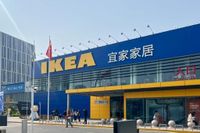China’s economic engine, once the envy of the world for its relentless pace, has been showing signs of fatigue in recent months. Data released on August 15, 2025, revealed a notable slowdown in July, as factory output, retail sales, and housing prices all slipped further. The world’s second-largest economy is not only grappling with internal challenges, like a cooling property market and rising unemployment, but also with the far-reaching environmental and health impacts of its booming e-commerce and express delivery sectors.
According to the National Bureau of Statistics, annual growth in industrial output dropped to 5.7% in July, down from 6.8% in June, marking an eight-month low. This deceleration was echoed across other key indicators. Investments in factory equipment and other fixed assets rose a meager 1.6% from January to July—down from 2.8% in the first half of the year—while property investments plunged 12% during the same period. Residential housing investment alone fell nearly 11%, and prices for newly built homes in major cities slipped 1.1% in July, extending a prolonged downturn that has dogged the sector since the onset of the COVID-19 pandemic.
Retail sales, a bellwether of consumer confidence, rose just 3.7% in July, the slowest rate in seven months and a drop from June’s 4.8% increase. The unemployment rate ticked up to 5.2% as a new crop of university graduates entered the job market, up from 5% in June. While consumer prices managed a modest 0.4% rise over the previous month, wholesale prices fell 3.6% year-on-year, further signaling weak demand in the broader economy.
Yet, amid this economic cooling, a different kind of surge is taking place—one that’s largely invisible but has profound implications for China’s environment and public health. The rapid rise of urban e-commerce has fueled an unprecedented expansion in express delivery services. This growth, while convenient for millions of Chinese consumers, has come at a steep ecological and human cost.
According to a groundbreaking study published in Nature Cities in 2025, China’s express delivery transportation sector emitted a staggering 23.9 million tons of CO2-equivalent and 166,400 tons of atmospheric pollutant equivalents in 2021 alone. The environmental burden of these emissions is far from evenly distributed. Key transit regions—those vital arteries connecting China’s major urban clusters—handled only 12.7% of parcels but were responsible for a whopping 37.3% of total emissions. Even more striking, 75.2% of air-pollution-related premature deaths in these regions were linked to delivery activities originating elsewhere.
The health toll is sobering. The same study found that express-delivery-related pollution caused approximately 5,100 premature deaths in 2021. The researchers, who integrated large-scale shipping records, geospatial modeling, and atmospheric chemical transport models, painted a picture of substantial environmental inequality. For instance, in Jiangxi Province, a staggering 94.5% of premature deaths were attributed to pollution from other regions’ delivery activities, underscoring the cross-provincial nature of the problem.
There is, however, a glimmer of hope. The study’s authors argue that implementing synergistic mitigation strategies—such as cleaner vehicles, optimized delivery routes, and stricter emissions standards—could prevent more than 256,000 cumulative premature deaths by 2050. The message is clear: while the convenience of next-day delivery is alluring, it comes with externalities that can no longer be ignored.
This environmental reckoning comes at a time when China is already contending with severe weather disruptions. Torrential seasonal rains have battered the country, causing flooding that has disrupted business activity in numerous provinces. The National Bureau of Statistics noted that the economy had shown "notable resilience and vitality against the complex and volatile external environment and adverse impacts from extreme domestic weather." Still, the compounding effects of climate change and unchecked emissions from sectors like express delivery threaten to erode these hard-won gains.
Trade, too, remains a wild card. After months of uncertainty, President Donald Trump extended a pause in sharp tariff hikes on Chinese exports for another 90 days, following an earlier truce that began in May. Businesses rushed to take advantage of this window, with China’s exports surging 7.2% year-on-year in July and imports growing at their fastest pace in a year. Yet, as Oxford Economics’ Sheana Yue observed, this uptick was partly due to a lower base for comparison and may not signal a lasting rebound. "Exports remained a bright spot although the boost from front-loading appears to be tapering off and has started to show up in weak industrial production, as we anticipated," Yue wrote in a report cited by the Associated Press.
Manufacturers, wary of future trade turbulence, have slowed investments, hiring, and production. Many have also shifted their focus to Southeast Asia, Africa, and other regions to offset lost business in the U.S. But as the export engine sputters and the property market remains in a slump, the government’s efforts to stimulate domestic demand are hamstrung by the very real constraints of household wealth—much of which is tied up in real estate.
"Chinese economic activity slowed across the board in July, with retail sales, fixed asset investment, and value added of industry growth all reaching the lowest levels of the year," Lynne Song of ING Economics noted in a report. The government has rolled out policies to ensure that most pre-paid housing projects are completed, but sales remain weak despite incentives aimed at luring families back into the market.
As China looks ahead, the stakes could hardly be higher. The express delivery sector, emblematic of the country’s digital transformation, is both a source of pride and a cause for concern. Without decisive action, the environmental and health costs of this convenience-driven economy threaten to overshadow its benefits. At the same time, the broader economic picture remains clouded by sluggish growth, weather shocks, and the persistent specter of trade wars.
For policymakers, business leaders, and citizens alike, the message seems clear: the path to sustainable prosperity will require balancing growth with environmental stewardship and public health protections. As the numbers from July and the findings from Nature Cities make plain, the time for that reckoning is now.

